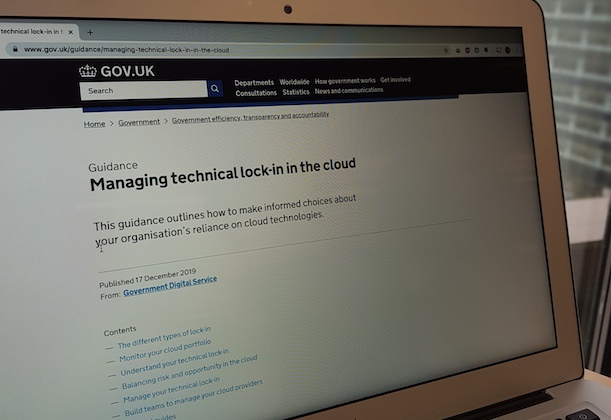
User researcher Leon Hubert and the GDS Technology Policy team have spent a lot of time this year doing research to find out what government organisations need to consider when using cloud.
One of the most important findings from the research was that government organisations are looking for more guidance and advice to help them choose appropriate cloud services. So today we’ve published our first piece of guidance about cloud lock-in.
Understanding cloud lock-in
Cloud lock-in is when you are dependent upon a particular cloud service and it would be very expensive or time-consuming to migrate to another service.
We chose to write about lock-in first because that was one of our most immediate user needs when talking about cloud. Lots of organisations we spoke to had different providers or used different services, but most of the time they had struggled to balance lock-in or fully understand the consequences of their provider decisions.
A lot of organisations are used to the risks and benefits of lock-in through commercial contracts, but we think cloud is different because a lot of the lock-in comes from the technical decisions you make. That’s why we start our new guidance outlining the differences between commercial and technical lock-in.
It’s critical for government organisations to consider lock-in whenever they build or architect anything in the cloud. There’s nothing necessarily wrong with being locked-in, but it might change the decisions they have to make in future.
For example, if you use a cloud service that is only available from one provider, you might have to rebuild your entire application if you later decide to switch provider. Or, you might find that locking-in to a specific technology like serverless can take away some of the worries you might have about configuring lots of security settings.
Balancing risk and opportunity in the cloud
Understanding the balance between value and portability is a really complex idea to communicate, so we developed a graph in the cloud lock-in guidance to make it more clear. We felt this was an important concept to talk about as it shows how complex the risks and opportunities of cloud lock-in can be.
Many (but not all) of the cloud services that provide the most value are the least portable and it’s important that organisations understand that trying to reduce cloud lock-in at all costs can reduce the value they get from the cloud.
For example, using a complex pre-built machine learning algorithm can mean you’re locked-in to that cloud provider. However, that lock-in is probably worth the cost if your alternative is having to create an entire machine learning service yourself. Understanding where you want to be on that value and portability graph should hopefully make it much easier to plan your longer-term strategy.
Home Office cost optimisation case study
Alongside writing the new guidance, Tom worked with Khidr Suleman, GDS Technical Writer, on a case study about how a team in the Home Office used cost optimisation techniques to reduce their cloud bill by 40%.
We’re grateful to the Home Office team for taking the time to share their learning with us; it was fascinating to understand the variety of different techniques they could use to reduce cloud costs.
Switching off some development services outside working hours and using good autoscaling techniques can not only reduce costs but also typically leads to a more hygienic cloud environment.
We think cost optimisation is an important topic and we’re also currently drafting some guidance that will build on some of the techniques that the Home Office used. That guidance should be released in early 2020.
Next steps
As we said in November, users need more than just pure technical cloud advice. We’re still working in close partnership with our commercial colleagues to keep producing information jointly and we plan to write another update on that in a few months.
We hope you find the first piece of cloud guidance on lock-in useful. We’re planning to release more in January as we continue to digest the findings from our user research.
One of the areas we’re considering is whether we can add more to our current guidance on how to choose a cloud hosting strategy. So, if you have any ideas about the advantages and disadvantages of single-cloud, multi-cloud or hybrid cloud approaches we’re keen to hear from you.
We’d also love to hear what you think of the guidance, please let us know via email at cloud-strategy@digital.cabinet-office.gov.uk or leave a comment below.
